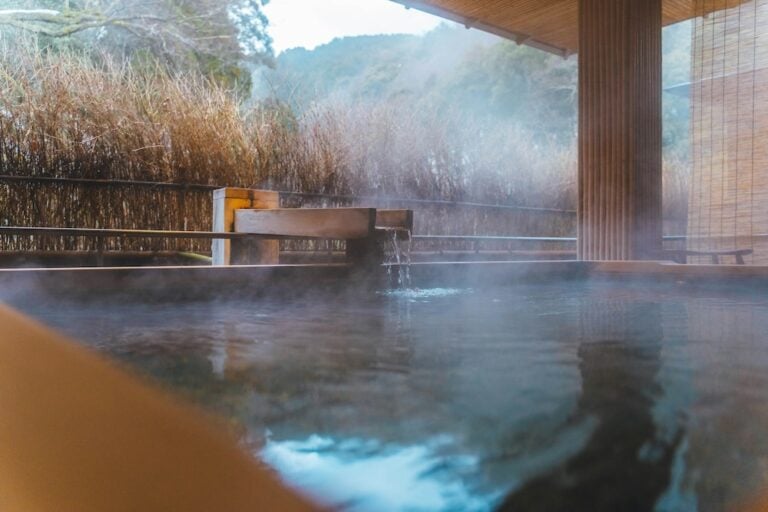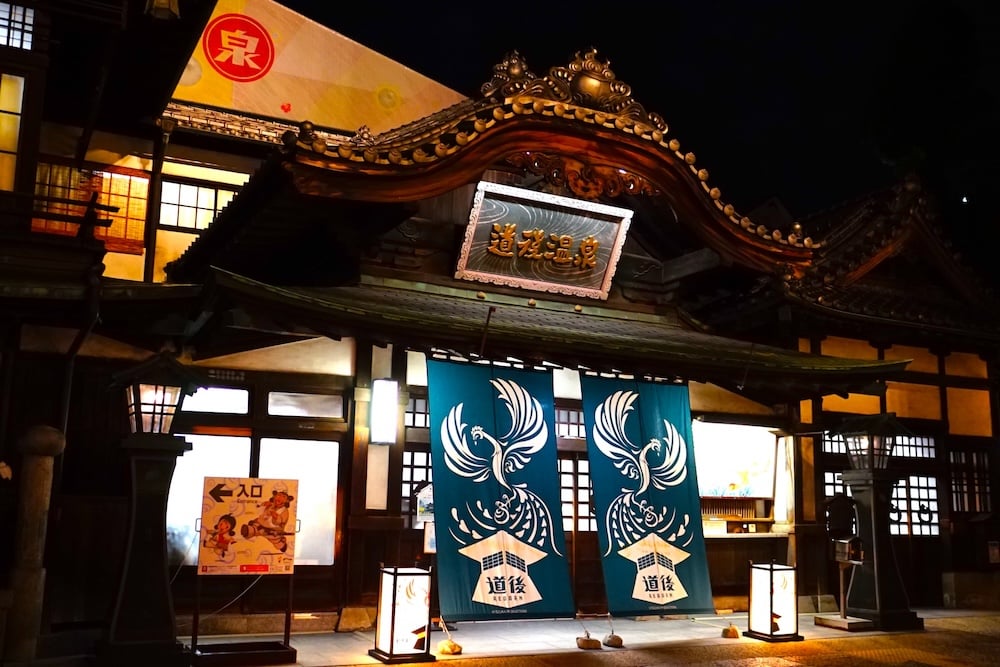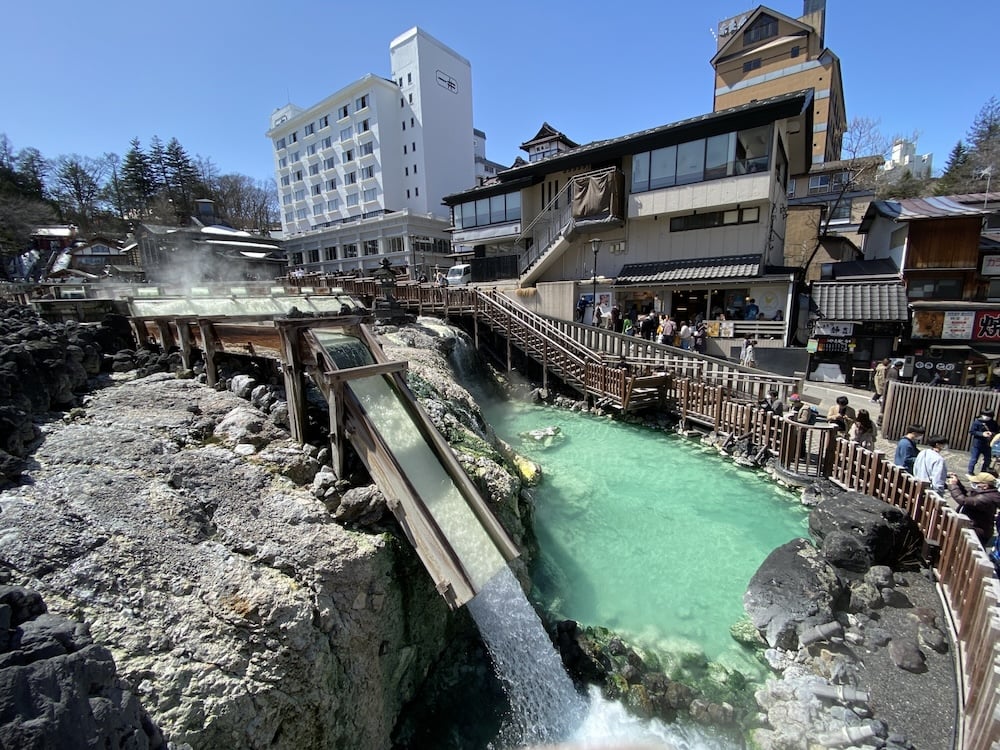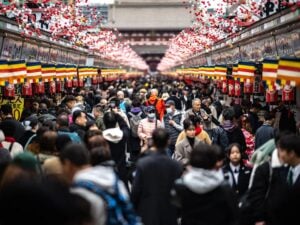
As a seismically active country with a large number of volcanoes, Japan is also home to a huge number of hot springs. There are estimated to be more than 25,000 hot spring sources in the country and bathing in them has historically been a big part of Japanese culture in terms of relaxation and leisure.
Hot springs, or onsen in Japanese, are popular any time of year but when the temperature drops in autumn, there’s nothing better than a soak in an onsen for warming you up and easing your muscles. In this article, we take a look at some of the most famous onsen in Japan as well as examine the etiquette of using an onsen if it’s something you’re new to.

Onsen History
It is not really known when hot spring bathing became popular in Japan as it predates written records. Bathing has long been a part of Japanese culture due to the influence of Shinto which emphasises cleanliness vs contamination but bathing in actual hot springs possibly emerged as part of medical treatment. There are references to hot springs in some of Japan’s oldest written records, usually in terms of them being used by emperors and their families for health reasons. It appears that a lot of the early usage of hot springs was for medicinal and healing purposes by the nobility and the samurai classes.
The more widespread usage of them is said to have originated in the Edo era as they became more accessible to common folk and visiting onsen became a popular pastime across the country. There are certain areas in Japan that have more onsen than others. For example, Tokyo and Osaka have barely any natural hot springs whereas more mountainous areas such as Oita or Nagano prefectures tend to have a lot more. Small towns and villages sprung up around popular hot springs and many of them still exist as onsen towns today.

Onsen Rules
Visiting an onsen for the first time can be intimidating. There are many rules to follow even before you get to the part about being naked in front of a bunch of strangers. Before we look at some of the more famous onsen in Japan, here’s a quick guide to the general rules of using an onsen.
First, the changing rooms: typically there are lockers or baskets for storing your clothes. You take off all your clothes here and leave your items behind. Some hot springs provide towels and others will either require you to bring your own or rent them. If you have a large towel, it needs to stay in the changing room for drying your body afterwards. Usually, you will take a small towel into the onsen area with you.
Next, once you have entered the actual bathing area, you need to wash your body before getting in the onsen. There will be rows of showers and you should use them to wash your body thoroughly. You can either use the showerhead or buckets of hot water to wash yourself. Usually there will be soap and shampoo provided for you. You should make sure that you’ve rinsed all the soap off before you step into the hot spring. Once you’ve finished, take your small towel with you and don’t leave it in the shower area.
Finally, you can enter the hot spring. You can use your towel to cover yourself when moving around outside the bath but once you’re in the hot spring itself, make sure your towel doesn’t touch the water. You can either place it next to you on the side of the bath or balance it on your head. Now it’s time to relax and let the hot water soothe your muscles. You shouldn’t stay in the bath too long as the hot water can make you dizzy so it’s best to get out and rest from time to time.
Other important rules from the onsen are that you shouldn’t put your head in the water. You should also refrain from talking loudly or splashing as the onsen is a time for relaxing. Tattoos are still prohibited from many onsen due cultural associations with crime however this is gradually changing and more and more onsen are becoming tattoo friendly. Still, it’s best to check if an onsen is tattoo friendly before visiting and respecting the requirements if it is not.

Famous Onsen in Japan
Kusatsu Onsen, Gunma
Located about two hours from Tokyo in Gunma prefecture, Kusatsu Onsen is consistently one of the most visited hot springs in Japan. The small onsen town has a huge volume of naturally free-flowing hot spring water and is renowned for its healing benefits. Kustatsu has been a popular destination for onsen enthusiasts for centuries but its popularity increased substantially when a renowned German doctor, Dr Eren Baelz, proclaimed Kusatsu’s waters unrivalled in their healing properties.
Dogo Onsen, Ehime
Located near the center of Ehime prefecture’s capital, Matsuyama city, Dogo onsen is a small onsen that is one of Japan’s oldest and most famous. The onsen’s history stretches back over a thousand years with there being various legends about its discovery in ancient times. It has been visited by various emperors and members of the imperial family throughout history and is also notable for being a favorite place of Natsume Soseki, one of Japan’s most famous novelists. In addition, Dogo onsen’s building is said to have been one of the inspirations for the bathhouse in the Oscar winning film, Spirited Away.
Arima Onsen
A short day trip from either Kobe or Osaka, Arima onsen is very well-known in the Kansai area and is also considered one of Japan’s three oldest onsen. The small town of Arima is a picturesque resort located at the foot of the Rokko mountain range and has become increasingly popular with international tourists due to its ease of access. Arima has two types of hot springs: kinsen (gold) and ginsen (silver). These two hot springs have different compositions and color, with the silver hot spring good for muscle aches and fatigue and the gold hot spring being good for the skin.
Shirahama Onsen
Another famous ancient hot spring located in the Kansai region, Shirahama is an onsen town overlooking the ocean with approximately 120 hot springs in the area. Shirahama is a little different from the other destinations on this list in that it very much has a modern resort feel with its beautiful beach, hotels and other attractions in the area. Still, it’s an area primarily famous for hot springs with the Saki-no-yu onsen in particular providing beautiful ocean views.
Noboribetsu Onsen
Though Hokkaido has many famous onsen, Noboribetsu onsen is probably the most well-known. This area has a wide variety of hot springs with many different kinds of water that each provide different benefits. Most of the hot springs originate from an area known as Jigokudani (Hell Valley), an area just above the town of Noboribetsu that was the site of a huge volcanic eruption 10,000 years ago. The area is also blessed with beautiful scenery and is a must visit if you’re interested in hot springs.
Relaxation At Its Best
Onsen are an interesting part of Japanese culture and a great way to relax after a long day. Natural onsen are often located in stunning locations so they are also a great way to get out and explore different parts of Japan. As the weather cools down towards the end of the year, there’s no better time to experience them.











